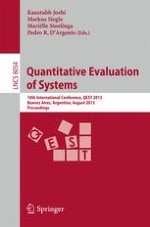2013 | Book
Quantitative Evaluation of Systems
10th International Conference, QEST 2013, Buenos Aires, Argentina, August 27-30, 2013. Proceedings
Editors: Kaustubh Joshi, Markus Siegle, Mariëlle Stoelinga, Pedro R. D’Argenio
Publisher: Springer Berlin Heidelberg
Book Series : Lecture Notes in Computer Science
